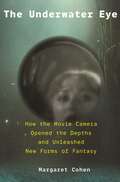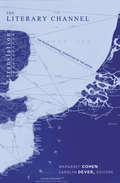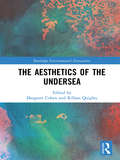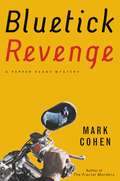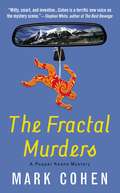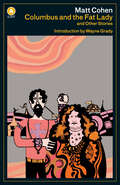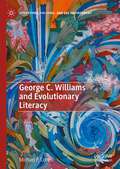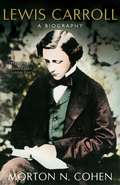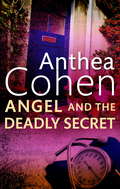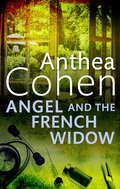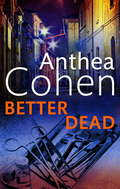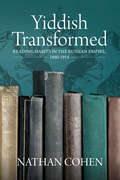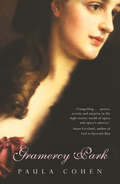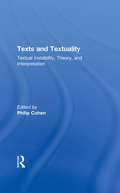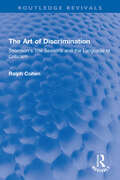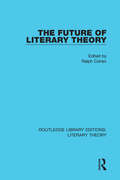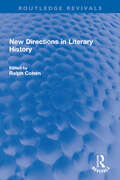- Table View
- List View
The Underwater Eye: How the Movie Camera Opened the Depths and Unleashed New Realms of Fantasy
by Margaret CohenA rich history of underwater filmmaking and how it has profoundly influenced the aesthetics of movies and public perception of the oceansIn The Underwater Eye, Margaret Cohen tells the fascinating story of how the development of modern diving equipment and movie camera technology has allowed documentary and narrative filmmakers to take human vision into the depths, creating new imagery of the seas and the underwater realm, and expanding the scope of popular imagination. Innovating on the most challenging film set on earth, filmmakers have tapped the emotional power of the underwater environment to forge new visions of horror, tragedy, adventure, beauty, and surrealism, entertaining the public and shaping its perception of ocean reality.Examining works by filmmakers ranging from J. E. Williamson, inventor of the first undersea film technology in 1914, to Wes Anderson, who filmed the underwater scenes of his 2004 The Life Aquatic with Steve Zissou entirely in a pool, The Underwater Eye traces how the radically alien qualities of underwater optics have shaped liquid fantasies for more than a century. Richly illustrated, the book explores documentaries by Jacques Cousteau, Louis Malle, and Hans Hass, art films by Man Ray and Jean Vigo, and popular movies and television shows such as 20,000 Leagues Under the Sea, Creature from the Black Lagoon, Sea Hunt, the Bond films, Jaws, The Abyss, and Titanic. In exploring the cultural impact of underwater filmmaking, the book also asks compelling questions about the role film plays in engaging the public with the remote ocean, a frontline of climate change.
The Underwater Eye: How the Movie Camera Opened the Depths and Unleashed New Realms of Fantasy
by Margaret CohenA rich history of underwater filmmaking and how it has profoundly influenced the aesthetics of movies and public perception of the oceansIn The Underwater Eye, Margaret Cohen tells the fascinating story of how the development of modern diving equipment and movie camera technology has allowed documentary and narrative filmmakers to take human vision into the depths, creating new imagery of the seas and the underwater realm, and expanding the scope of popular imagination. Innovating on the most challenging film set on earth, filmmakers have tapped the emotional power of the underwater environment to forge new visions of horror, tragedy, adventure, beauty, and surrealism, entertaining the public and shaping its perception of ocean reality.Examining works by filmmakers ranging from J. E. Williamson, inventor of the first undersea film technology in 1914, to Wes Anderson, who filmed the underwater scenes of his 2004 The Life Aquatic with Steve Zissou entirely in a pool, The Underwater Eye traces how the radically alien qualities of underwater optics have shaped liquid fantasies for more than a century. Richly illustrated, the book explores documentaries by Jacques Cousteau, Louis Malle, and Hans Hass, art films by Man Ray and Jean Vigo, and popular movies and television shows such as 20,000 Leagues Under the Sea, Creature from the Black Lagoon, Sea Hunt, the Bond films, Jaws, The Abyss, and Titanic. In exploring the cultural impact of underwater filmmaking, the book also asks compelling questions about the role film plays in engaging the public with the remote ocean, a frontline of climate change.
The Literary Channel: The Inter-National Invention of the Novel
by Margaret Cohen Carolyn DeverThe Literary Channel defines a crucial transnational literary "zone" that shaped the development of the modern novel. During the first two centuries of the genre's history, Britain and France were locked in political, economic, and military struggle. The period also saw British and French writers, critics, and readers enthusiastically exchanging works, codes, and theories of the novel. Building on both nationally based literary history and comparatist work on poetics, this book rethinks the genre's evolution as marking the power and limits of modern cultural nationalism. In the Channel zone, the novel developed through interactions among texts, readers, writers, and translators that inextricably linked national literary cultures. It served as a forum to promote and critique nationalist clichés, whether from the standpoint of Enlightenment cosmopolitanism, the insurgent nationalism of colonized spaces, or the non-nationalized culture of consumption. In the process, the Channel zone promoted codes that became the genre's hallmarks, including the sentimental poetics that would shape fiction through the nineteenth century. Uniting leading critics who bridge literary history and theory, The Literary Channel will appeal to all readers attentive to the future of literary studies, as well as those interested in the novel's development, British and French cultural history, and extra-national patterns of cultural exchange. Contributors include April Alliston, Emily Apter, Margaret Cohen, Joan DeJean, Carolyn Dever, Lynn Festa, Françoise Lionnet, Deidre Shauna Lynch, Sharon Marcus, Richard Maxwell, and Mary Helen McMurran.
The Literary Channel: The Inter-National Invention of the Novel
by Margaret Cohen Carolyn DeverThe Literary Channel defines a crucial transnational literary "zone" that shaped the development of the modern novel. During the first two centuries of the genre's history, Britain and France were locked in political, economic, and military struggle. The period also saw British and French writers, critics, and readers enthusiastically exchanging works, codes, and theories of the novel. Building on both nationally based literary history and comparatist work on poetics, this book rethinks the genre's evolution as marking the power and limits of modern cultural nationalism. In the Channel zone, the novel developed through interactions among texts, readers, writers, and translators that inextricably linked national literary cultures. It served as a forum to promote and critique nationalist clichés, whether from the standpoint of Enlightenment cosmopolitanism, the insurgent nationalism of colonized spaces, or the non-nationalized culture of consumption. In the process, the Channel zone promoted codes that became the genre's hallmarks, including the sentimental poetics that would shape fiction through the nineteenth century. Uniting leading critics who bridge literary history and theory, The Literary Channel will appeal to all readers attentive to the future of literary studies, as well as those interested in the novel's development, British and French cultural history, and extra-national patterns of cultural exchange. Contributors include April Alliston, Emily Apter, Margaret Cohen, Joan DeJean, Carolyn Dever, Lynn Festa, Françoise Lionnet, Deidre Shauna Lynch, Sharon Marcus, Richard Maxwell, and Mary Helen McMurran.
The Aesthetics of the Undersea (Routledge Environmental Humanities)
by Margaret Cohen Killian QuigleyAmong global environments, the undersea is unique in the challenges it poses – and the opportunities it affords – for sensation, perception, inquiry, and fantasy. The Aesthetics of the Undersea draws case studies in such potencies from the subaqueous imaginings of Western culture, and from the undersea realities that have inspired them. The chapters explore aesthetic engagements with underwater worlds, and sustain a concern with submarine "sense," in several meanings of that word: when submerged, faculties and fantasies transform, confronting human subjects with their limitations while enlarging the apparent scope of possibility and invention. Terrestrially-established categories and contours shift, metamorphose, or fail altogether to apply. As ocean health acquires an increasing share of the global environmental imaginary, the histories of submarine sense manifest ever-greater importance, and offer resources for documentation as well as creativity. The chapters deal with the sensory, material, and formal provocations of the underwater environment, and consider the consequences of such provocations for aesthetic and epistemological paradigms. Contributors, who hail from the United States, United Kingdom and Australia, include scholars of literature, art, new media, music and history. Cases studies range from baroque and rococo fantasies to the gothic, surrealism, modernism, and contemporary installation art. By juxtaposing early modern and Enlightenment contexts with matters of more recent – and indeed contemporary – importance, The Aesthetics of the Undersea establishes crucial relations among temporally remote entities, which will resonate across the environmental humanities.
The Aesthetics of the Undersea (Routledge Environmental Humanities)
by Margaret Cohen Killian QuigleyAmong global environments, the undersea is unique in the challenges it poses – and the opportunities it affords – for sensation, perception, inquiry, and fantasy. The Aesthetics of the Undersea draws case studies in such potencies from the subaqueous imaginings of Western culture, and from the undersea realities that have inspired them. The chapters explore aesthetic engagements with underwater worlds, and sustain a concern with submarine "sense," in several meanings of that word: when submerged, faculties and fantasies transform, confronting human subjects with their limitations while enlarging the apparent scope of possibility and invention. Terrestrially-established categories and contours shift, metamorphose, or fail altogether to apply. As ocean health acquires an increasing share of the global environmental imaginary, the histories of submarine sense manifest ever-greater importance, and offer resources for documentation as well as creativity. The chapters deal with the sensory, material, and formal provocations of the underwater environment, and consider the consequences of such provocations for aesthetic and epistemological paradigms. Contributors, who hail from the United States, United Kingdom and Australia, include scholars of literature, art, new media, music and history. Cases studies range from baroque and rococo fantasies to the gothic, surrealism, modernism, and contemporary installation art. By juxtaposing early modern and Enlightenment contexts with matters of more recent – and indeed contemporary – importance, The Aesthetics of the Undersea establishes crucial relations among temporally remote entities, which will resonate across the environmental humanities.
Bluetick Revenge
by Mark Cohen- Mark Cohen's debut novel, "The Fractal Murders, was originally self-published and was chosen as a Book Sense 76 Top 10 Mystery in 2002 and was a finalist for the Colorado Book Award. Mysterious Press published a revised hardcover edition in 5/04. The book has received terrific reviews from "Publishers Weekly, Booklist, Kirkus Reviews, Dallas Morning News, and the "Santa Fe New Mexican.- Cohen's experience as a former JAG and municipal judge in Boulder, Colorado, gives his novels a terrific insider's perspective. His writing has also appeared in various magazines, including "Inside Kung Fu and "Camping & RV Magazine.
The Fractal Murders: A Pepper Keane Mystery
by Mark CohenJane Smythe, a math professor specializing in fractal geometry, is shocked to learn that three professors with the same specialty have died amid mysterious circumstances. That's where Pepper Keane, an ex-Marine turned PI with an encyclopedic knowledge of rock 'n' roll, comes in. He finds himself attracted to Professor Smythe and is determined to discover the root of these incidents. At first, he can't find any evidence that the three dead mathematicians even knew each other. But Keane, with the help of his hacker best friend and exercise guru brother, continues to dig. Suspects begin to appear and then multiply as they race through the rocky terrain of Colorado to Mexico, Boston, and Nebraska - with the main suspect an FBI agent who is also Keane's worst enemy.
Columbus and the Fat Lady: And Other Stories (A List)
by Matt CohenFirst published in 1972, Columbus and the Fat Lady introduced readers to Governor General’s Literary Award–winning author Matt Cohen’s skewed and hilarious worldview. By turns funny, surreal, wistful, savagely satirical, and brilliantly inventive, the stories in this collection intrigue and surprise the reader with their unexpected language and plots. He conjures up images that are both absurd and perceptive. From Sir Galahad as a schoolteacher to Christopher Columbus as a carnival attraction, these stories feature the improbable with strength and virtuosity. This collection is a foray into the jungles of life on this planet and the tangled but fascinating interiors of the human head.
George C. Williams and Evolutionary Literacy (Literatures, Cultures, and the Environment)
by Michael P. CohenIn this book, a case study of a humanistic reading of an essential evolutionary theorist, George C. Williams (May 12, 1926–September 8, 2010), the author contends that certain classic works of evolutionary theory and history are the most important nature writing of recent times. What it means to be scientifically literate—is essential for humanistic scholars, who must ground themselves with literary reading of scientific texts. As the most influential American evolutionary theorist of the second half of the twentieth century, Williams masters critique, frames questions about adaptation and natural selection, and answers in a plain, aphoristic writing style. Williams aims for parsimony—to “recognize adaptation at the level necessitated by the facts and no higher”—through a minimalist writing style. This voice articulates a powerful process that operates at very low levels by blind and selfish chance at the expense of its designed products, using purely trial and error.
Lewis Carroll: A Biography
by Morton CohenCharles Lutwidge Dodgson was a pioneering photographer, Oxford don and mathematician, who - as Lewis Carroll - gave the world not only Alice, but the Jabberwocky, the Red Queen, the Mad Hatter, the March Hare, the Cheshire Cat and an unforgettable tea party. But who was he?In this elegant, affectionate biography, Morton N. Cohen brings a singular expertise - drawn from some thirty years' scholarship on Carroll as well as from special access to the Dodgson family documents - to the riddle of the quiet, stammering man who liberated children's books from the moralists and whose imagination brought forth some of the funniest nonsense, wildest characters and most extraordinary cultural icons of modern times.His life has puzzled psychologists and literary historians for generations. Now, with full mastery of Caroll's letters and voluminous diaries, Cohen explores as never before the paradox of the man: the unworldly innocent whose passionate worship of young girls has incited endless speculation; the Victorian gentleman whose sombre religious meditations shared a place in his mind with the Snark and the Boojum; the cloistered, lonely bachelor don whose magical books are known in every culture in the world today.What emerges is a portrait that is filled with admiration for Carroll's accomplishment, delight in his playfulness and charm and sympathy for the self-reproach and emotional turbulence that lay beneath Carroll's apparently placid existence. Lewis Carroll: A Biography is an extraordinary work of literary scholarship.
Angel and the Deadly Secret: The 17th Agnes Turner chiller (Agnes Carmichael #17)
by Ms Anthea CohenLife for Agnes Turner in her retirement is dull and uneventful. That is until she spots her mousy neighbour Amy Horrocks fleeing along the road in terror. When Agnes takes her in, Amy sobs out her distress: she is in fear of her life, harbouring a dark secret for which she is being blackmailed. Amy turns to Agnes for help, and Agnes, eternally supportive in the face of injustice, deals with the situation in her own, inimitable way.
Angel and the French Widow (Agnes Carmichael #16)
by Ms Anthea CohenThere is nothing Agnes Turner (née Carmichael) hates more than cruelty to animals. So when she sees a pup being abused by a boy she takes instant action. Days later her car is vandalised and so sure is she that the same boy is responsible that she takes the precaution of going to the police. However, when Agnes' French neighbour, a woman who bears a striking resemblance to Agnes, is found dead, a more direct approach is called for. The boy is a drug addict and careless so it isn't long before Agnes has a chance to dispense her own unique and deadly form of justice!
Better Dead (Agnes Carmichael #18)
by Ms Anthea CohenWhen Agnes Turner is witness to a rape, she goes for the assailant with a knife - with fatal consequences. The victim repays Agnes by blackmailing her, and when Agnes refuses her demands she kidnaps her beloved Jack Russell terrier. Agnes faces the prospect of committing yet another crime to secure the safe return of her dog. But then another death occurs . . . In this, the 18th in the Agnes Turner mysteries, Anthea Cohen remains the mistress of the icy touch.
Yiddish Transformed: Reading Habits in the Russian Empire, 1860-1914
by Nathan CohenAs significant economic, social, political, and cultural transformations swept the Jewish population of Tsarist Russia and Congress Poland between 1860 and 1914, the Yiddish language (Zhargon) began to gain recognition as a central part of the Jewish cultural stage. Yiddish Transformed examines the secular reading habits of East-European Jews as the Jewish community began shifting to a modern society. Author Nathan Cohen explores Jewish reading practices alongside the rise of Yiddish by delving into publishing policies of Yiddish books and newspapers, popular literary genres of the time, the development of Jewish public libraries, as well as personal reflections of reading experiences.
Yiddish Transformed: Reading Habits in the Russian Empire, 1860-1914
by Nathan CohenAs significant economic, social, political, and cultural transformations swept the Jewish population of Tsarist Russia and Congress Poland between 1860 and 1914, the Yiddish language (Zhargon) began to gain recognition as a central part of the Jewish cultural stage. Yiddish Transformed examines the secular reading habits of East-European Jews as the Jewish community began shifting to a modern society. Author Nathan Cohen explores Jewish reading practices alongside the rise of Yiddish by delving into publishing policies of Yiddish books and newspapers, popular literary genres of the time, the development of Jewish public libraries, as well as personal reflections of reading experiences.
Yiddish Transformed: Reading Habits in the Russian Empire, 1860-1914
by Nathan CohenAs significant economic, social, political, and cultural transformations swept the Jewish population of Tsarist Russia and Congress Poland between 1860 and 1914, the Yiddish language (Zhargon) began to gain recognition as a central part of the Jewish cultural stage. Yiddish Transformed examines the secular reading habits of East-European Jews as the Jewish community began shifting to a modern society. Author Nathan Cohen explores Jewish reading practices alongside the rise of Yiddish by delving into publishing policies of Yiddish books and newspapers, popular literary genres of the time, the development of Jewish public libraries, as well as personal reflections of reading experiences.
Gramercy Park: A Novel (Large Print Ser.)
by Paula CohenPaul Cohen’s sumptumous debut novel captures the high drama and low dealings that lie behind the polished facade of fin de siecle New York.
Texts and Textuality: Textual Instability, Theory, and Interpretation (Wellesley Studies in Critical Theory, Literary History and Culture)
by Philip G. CohenThese essays deal with the scholarly study of the genesis, transmission, and editorial reconstitution of texts by exploring the connections between textual instability and textual theory, interpretation, and pedagogy.What makes this collection unique is that each essay brings a different theoretical orientation-New Historicism, Poststructuralism, or Feminism-to bear upon a different text, such as Whitman's Leaves of Grass, Faulkner's The Sound and the Fury, or hypertext fiction, to explore the dialectical relationship between texts and textuality.The essays bring some of the textual theories that compete with each other today into contact with a broad range of primarily literary textual histories. That texts are intrinsically unstable, frequently consisting of a series of determinate historical versions, has consequences for all students of literature, because different versions of a literary work frequently help shape different readings independently of the interpretations brought to bear upon them. Textual instability of the works is relevant to our understanding of how the meanings of texts are generated. The contributors build on the numerous challenges to the Anglo-American editorial tradition mounted during the past decade by scholars as diverse as Jerome McGann, D.F. McKenzie, Peter Shillingsburg, D.C. Greetham, Hershel Parker, and Hans Walter Gabler. The volume contributes to the paradigm shift in textual scholarship inaugurated by these scholars. Index.
Texts and Textuality: Textual Instability, Theory, and Interpretation (Wellesley Studies in Critical Theory, Literary History and Culture #Vol. 13)
by Philip G. CohenThese essays deal with the scholarly study of the genesis, transmission, and editorial reconstitution of texts by exploring the connections between textual instability and textual theory, interpretation, and pedagogy.What makes this collection unique is that each essay brings a different theoretical orientation-New Historicism, Poststructuralism, or Feminism-to bear upon a different text, such as Whitman's Leaves of Grass, Faulkner's The Sound and the Fury, or hypertext fiction, to explore the dialectical relationship between texts and textuality.The essays bring some of the textual theories that compete with each other today into contact with a broad range of primarily literary textual histories. That texts are intrinsically unstable, frequently consisting of a series of determinate historical versions, has consequences for all students of literature, because different versions of a literary work frequently help shape different readings independently of the interpretations brought to bear upon them. Textual instability of the works is relevant to our understanding of how the meanings of texts are generated. The contributors build on the numerous challenges to the Anglo-American editorial tradition mounted during the past decade by scholars as diverse as Jerome McGann, D.F. McKenzie, Peter Shillingsburg, D.C. Greetham, Hershel Parker, and Hans Walter Gabler. The volume contributes to the paradigm shift in textual scholarship inaugurated by these scholars. Index.
The Art of Discrimination: Thomson's The Seasons and the Language of Criticism (Routledge Revivals)
by Ralph CohenFirst published in 1964, The Art of Discrimination is a study in the relation between critical theory and practice, taking as its test-case James Thomson’s The Seasons, the poem which was, according to Johnson, of "a new kind". Professor Cohen explores the different applications of criticism from 1750 to 1950, analysing specific interpretations of the poem that altered, contradicted or supported poetic theory. In doing so, he introduces new techniques to supplement traditional critical commentary: illustrations are treated as interpretations and critical language is related to non-literary as well as literary information. In treating the history of critical interpretation, the reprinting of editions and past interpretations are considered along with contemporary statements as necessary to define a literary period. The book offers alternatives to theories of organicism and to those of the arbitrariness of literary history by defining the kinds of continuities that exist in criticism. As analysis of criticism, it studies how men think about literature, the extent to which such thinking resists systematization and those elements in it which can be controlled and organized and transmitted. The book will appeal to students of literature and critical theory.
The Art of Discrimination: Thomson's The Seasons and the Language of Criticism (Routledge Revivals)
by Ralph CohenFirst published in 1964, The Art of Discrimination is a study in the relation between critical theory and practice, taking as its test-case James Thomson’s The Seasons, the poem which was, according to Johnson, of "a new kind". Professor Cohen explores the different applications of criticism from 1750 to 1950, analysing specific interpretations of the poem that altered, contradicted or supported poetic theory. In doing so, he introduces new techniques to supplement traditional critical commentary: illustrations are treated as interpretations and critical language is related to non-literary as well as literary information. In treating the history of critical interpretation, the reprinting of editions and past interpretations are considered along with contemporary statements as necessary to define a literary period. The book offers alternatives to theories of organicism and to those of the arbitrariness of literary history by defining the kinds of continuities that exist in criticism. As analysis of criticism, it studies how men think about literature, the extent to which such thinking resists systematization and those elements in it which can be controlled and organized and transmitted. The book will appeal to students of literature and critical theory.
The Future of Literary Theory (Routledge Library Editions: Literary Theory)
by Ralph CohenIn this book, first published in 1989, twenty-give eminent critics and theorists write about different aspects of literary theory. These essays represent leading research in psychoanalytic criticism, new historicism, Continental theory, feminism, Afro-American studies, philosophy, cybernetics, aesthetics, and other theoretical inflections. The result is a collective statement on the course that lies ahead for criticism in the humanities, and will be of interest to students of literary theory.
The Future of Literary Theory (Routledge Library Editions: Literary Theory)
by Ralph CohenIn this book, first published in 1989, twenty-give eminent critics and theorists write about different aspects of literary theory. These essays represent leading research in psychoanalytic criticism, new historicism, Continental theory, feminism, Afro-American studies, philosophy, cybernetics, aesthetics, and other theoretical inflections. The result is a collective statement on the course that lies ahead for criticism in the humanities, and will be of interest to students of literary theory.
New Directions in Literary History: New Directions In Literary History (1974) (Routledge Revivals)
by Ralph CohenFirst published in 1974, New Directions in Literary History is a comprehensive attempt to present approaches to literary studies that have developed from phenomenology, stylistics and linguistics, Marxist reconsiderations of literature, interdisciplinary studies and analysis of reader response. Written by an international group of scholars, the essays are taken from the pages of New Literary History. They range from the Middle Ages to contemporary literature. European and American literary critics are here represented, together with an art critic, a philosopher and a novelist. Their essays deal with crucial problems in the study of literature: the relationship of the contemporary critic to works of the past; the place of method in literary study; how reading takes place; the role of the reader in different literary periods in providing a guide to interpretation; the language of literature and its relation to natural or ordinary language; the origin and decline of literary forms; and what constitutes literature, especially in the relation between fictional character and autobiography. Although the essays are essentially concerned with theoretical issues, they also examine the practical applications to literature. Students of English literature and literary theory will find this book particularly interesting.
